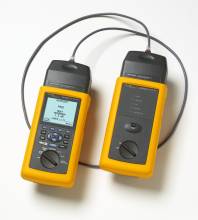Are you aware that most Category 6 patch cords available on the market today actually FAIL the requirements outlined by the TIA/EIA standards commitee? It's true!
It has been a common misconseption that a patch cord can be connected between the main and remote units of a standard Category 6 tester, hit "autotest" and presto...certified Cat 6! This is incorrect. Most Category 6 testers that have female RJ45 jacks as inputs are designed to test for Category 6 Channel compliance. This means that the tester has been programmed to evaluate an entire cable drop consisting of a full 90 meters of horizontal cable, a wall outlet, a patch panel and 2 - 5 meter patch cords. The tester is allowing for the associated signal loss of all of these components combined and applying it to just the patch cord, practically any patch cord could pass this test!
Even more alarming is the fact that most network cabling installations are tested for "Permanent Link" compliance only. This means that the cabling drop is tested from the wall outlet to the patch panel without including the patch cords that will be used in the actual network application. If the Permanent Link has been verified and the patch cord says Cat 6, everything is compliant, right? Probably not. Most patch cords that say Cat 6 will not pass the actual component test.
In mid 2002 the TIA issued the industry's first patch cord test procedure (TIA/EIA-568-B.2-1, Annex J). This test procedure requires a network analyzer, complex fixturing, and highly trained personnel. It is not intended for use in the field or a production environment. This method is almost never used to test patch cords.
Early in 2003, Fluke Networks introduced a patch cord test adaptor that simply and efficiently tests cords to the full requirements of TIA/EIA-568-B; including length, NEXT, wire map, and return loss. This new test ability allows quick and accurate patch cord evaluation and the results can be alarming.
It has been discovered that manufacturing a truely compliant Category 6 patch cord is not as simple as taking a piece of cable that says "Cat 6" and crimping RJ45 plugs on the ends. The cable must be of the highest quality (such as Quabbin Wire and Cable's Datamax 6E) and the connector must be truely Category 6 Component compliant (such as Sentinel's innovative connector designs). The manufacturing process must precisely maintain the pair twist during application of the connectors and the cable must be handled properly. Even after all of these steps are taken all cables will not pass, therefore a 100% compliance test using Flukes DSP 4000 series tester with patch cord adapters must be performed to weed out the failing assemblies.


Sentinel Cat 6 Plug Fluke DSP 4000 Series Tester
The hard fact is that a failing cord will not cause a network to fail. A workstation can be connected to a server and everything appears to be working properly, but is it communicating to it's full capability?
The implementation of TIA/EIA standards in the cabling industry has been a real benefit to consumers, it is a great way to know what you are buying. Be sure that all of your Premises Wiring components are fully compliant, including the patch cords. Click here to see our full line of 100% tested Component Rated Cat 6 patch cords.
Don't let a simple patch cord be the weakest link in your state of the art cabling system.
click here to see our selection of Component Rated patch cords



